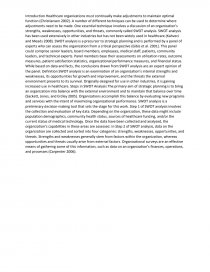For Swot Analysis
Essay by Daniel Tung Huang Tie • March 23, 2018 • Essay • 377 Words (2 Pages) • 1,178 Views
Introduction Healthcare organizations must continually make adjustments to maintain optimal function (Christiansen 2002). A number of different techniques can be used to determine where adjustments need to be made. One essential technique involves a discussion of an organization’s strengths, weaknesses, opportunities, and threats, commonly called SWOT analysis. SWOT analysis has been used extensively in other industries but has not been widely used in healthcare (Kahveci and Meads 2008). SWOT analysis is a precursor to strategic planning and is performed by a panel of experts who can assess the organization from a critical perspective (Gibis et al. 2001). This panel could comprise senior leaders, board members, employees, medical staff, patients, community leaders, and technical experts. Panel members base their assessments on utilization rates, outcome measures, patient satisfaction statistics, organizational performance measures, and financial status. While based on data and facts, the conclusions drawn from SWOT analysis are an expert opinion of the panel. Definition SWOT analysis is an examination of an organization’s internal strengths and weaknesses, its opportunities for growth and improvement, and the threats the external environment presents to its survival. Originally designed for use in other industries, it is gaining increased use in healthcare. Steps in SWOT Analysis The primary aim of strategic planning is to bring an organization into balance with the external environment and to maintain that balance over time (Sackett, Jones, and Erdley 2005). Organizations accomplish this balance by evaluating new programs and services with the intent of maximizing organizational performance. SWOT analysis is a preliminary decision-making tool that sets the stage for this work. Step 1 of SWOT analysis involves the collection and evaluation of key data. Depending on the organization, these data might include population demographics, community health status, sources of healthcare funding, and/or the current status of medical technology. Once the data have been collected and analyzed, the organization’s capabilities in these areas are assessed. In Step 2 of SWOT analysis, data on the organization are collected and sorted into four categories: strengths, weaknesses, opportunities, and threats. Strengths and weaknesses generally stem from factors within the organization, whereas opportunities and threats usually arise from external factors. Organizational surveys are an effective means of gathering some of this information, such as data on an organization’s finances, operations, and processes (Carpenter 2006).
...
...
